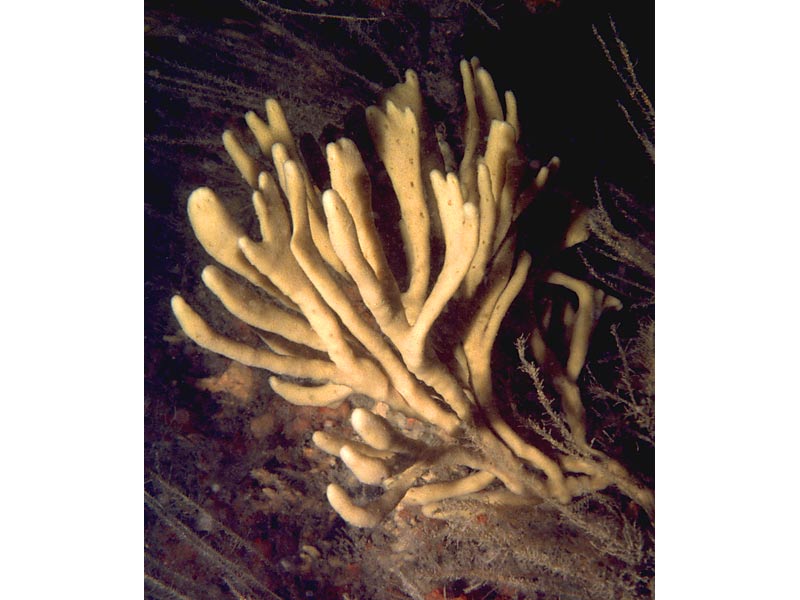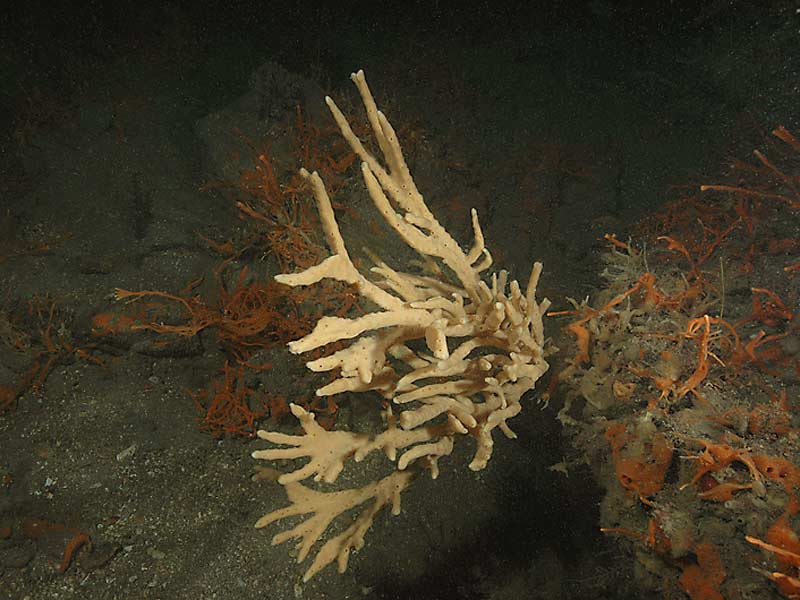Mermaid's Glove (Haliclona (Haliclona) oculata)
Distribution data supplied by the Ocean Biodiversity Information System (OBIS). To interrogate UK data visit the NBN Atlas.Map Help
| Researched by | Edward Mayhew | Refereed by | This information is not refereed |
| Authority | (Linnaeus, 1759) | ||
| Other common names | - | Synonyms | - |
Summary
Description
Recorded distribution in Britain and Ireland
Recorded from the Shetland Isles, Cromarty Firth, Firth of Forth, Northumberland, southern coasts of England, Isles of Scilly, north Devon, Wales, Cumbria, western Scotland, Hebrides, northern Ireland, east, south west and west coasts of Ireland.Global distribution
This is a northern species, occurring all around the North Atlantic (including Canada and North America), as far south as Portugal. Thought to also occur in the entire Arctic and sub-Arctic area.Habitat
Haliclona oculata can be found on open coasts and the outer reaches of estuaries, usually shallow water to about 100 m depth. The species is often associated with rather silted water. Usually on rocky or sandy substrata, often attached to stones and rocks. Can tolerate low salinity and turbid water with suspended silt.
Depth range
0 - 100 mIdentifying features
- Sponge consists of solid branches growing from a short stalk, which is attached to the substratum.
- Oscules (exhalent openings) are small and arranged along the branches in rows.
- The diameter of the branches often decreases towards the blind end.
- Branches are often laterally compressed, with oscules mainly arranged on the narrower sides of the compressed branches.
- Soft but elastic, not fragile, but becoming firmer towards the base.
- Outer layer skeleton is mostly absent.
- Spicules take the form of a single straight axis (monaxon), with both ends tapering to a point (oxea).
- Oxeas are short and fat, with short and sharp points.
Additional information
Under sheltered conditions, branches are occasionally flattened, antler-shaped and less numerous. The shape and degree of branching are greatly affected by the strength of the current flow, with the much branched form found in strong currents.Listed by
- none -
Bibliography
Hayward, P.J. & Ryland, J.S. (ed.) 1995b. Handbook of the marine fauna of North-West Europe. Oxford: Oxford University Press.
Howson, C.M. & Picton, B.E., 1997. The species directory of the marine fauna and flora of the British Isles and surrounding seas. Belfast: Ulster Museum. [Ulster Museum publication, no. 276.]
Moss, D., & Ackers, G. (eds.), 1982. The UCS Sponge Guide. Produced by R. Earll. Ross-on-Wye: The Underwater Conservation Society.
Stachowitsch, M., 1992. The invertebrates: an illustrated glossary. USA: Wiley-Liss.
Van Soest, R. 2015. Haliclona oculata. Sponges of the NE. Atlantic Marine Species Identification Portal [On-line]. ETI BioInformatics in the KeyToNature programme. Available from: http://species-identification.org/species.php?species_group=sponges&id=251
Datasets
Centre for Environmental Data and Recording, 2018. Ulster Museum Marine Surveys of Northern Ireland Coastal Waters. Occurrence dataset https://www.nmni.com/CEDaR/CEDaR-Centre-for-Environmental-Data-and-Recording.aspx accessed via NBNAtlas.org on 2018-09-25.
Environmental Records Information Centre North East, 2018. ERIC NE Combined dataset to 2017. Occurrence dataset: http://www.ericnortheast.org.ukl accessed via NBNAtlas.org on 2018-09-38
Kent Wildlife Trust, 2018. Kent Wildlife Trust Shoresearch Intertidal Survey 2004 onwards. Occurrence dataset: https://www.kentwildlifetrust.org.uk/ accessed via NBNAtlas.org on 2018-10-01.
Manx Biological Recording Partnership, 2022. Isle of Man historical wildlife records 1990 to 1994. Occurrence dataset:https://doi.org/10.15468/aru16v accessed via GBIF.org on 2024-09-27.
National Trust, 2017. National Trust Species Records. Occurrence dataset: https://doi.org/10.15468/opc6g1 accessed via GBIF.org on 2018-10-01.
NBN (National Biodiversity Network) Atlas. Available from: https://www.nbnatlas.org.
OBIS (Ocean Biodiversity Information System), 2025. Global map of species distribution using gridded data. Available from: Ocean Biogeographic Information System. www.iobis.org. Accessed: 2025-07-24
South East Wales Biodiversity Records Centre, 2023. SEWBReC Marine and other Aquatic Invertebrates (South East Wales). Occurrence dataset:https://doi.org/10.15468/zxy1n6 accessed via GBIF.org on 2024-09-27.
Suffolk Biodiversity Information Service., 2017. Suffolk Biodiversity Information Service (SBIS) Dataset. Occurrence dataset: https://doi.org/10.15468/ab4vwo accessed via GBIF.org on 2018-10-02.
Citation
This review can be cited as:
Last Updated: 15/12/2006





